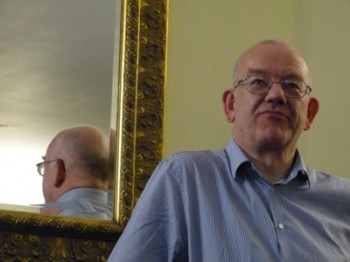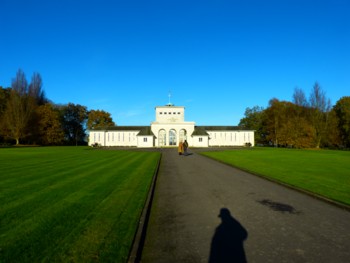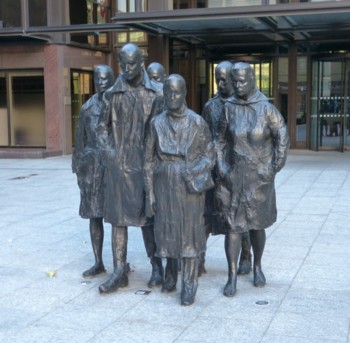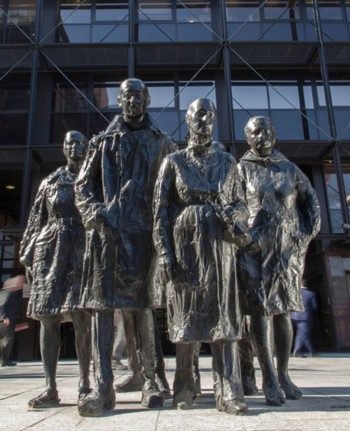We are developing the social individualist meta-context for the future. From the very serious to the extremely frivolous... lets see what is on the mind of the Samizdata people.
Samizdata, derived from Samizdat /n. - a system of clandestine publication of banned literature in the USSR [Russ.,= self-publishing house]
|
Browsing Instapundit this morning, I found this link to this video…
Update:
Commenter Alisa contributed a link that includes a pointer to the Homeland Security Grant Application (PDF) by the Concord police department.
Section 1 B begins:

It would be interesting to hear the specifics of what kind of “active and present daily challenges” the Free Staters constitute.
I have long admired the libertarian historian and activist Stephen Davies, my previous posting here about him being this one, in connection with a talk he recently gave to Libertarian Home, in the superbly opulent setting of the Counting House‘s Griffin Room, in the City of London.
Here is a photo of Davies that I took that night:

Here is another, together with a photo of someone else also photoing him.
The Davies talk was predictably excellent, and this on a day when he had also given another talk elsewhere in southern England somewhere, to a bunch of sixth formers. I know this because I happened to share a tube journey with Davies afterwards, during which we talked about, among other things, his day, and why he was so very tired. I don’t recall where this other talk was, but do recall that it was definitely out of London and that Davies also organised for three other speakers to be present, as well as himself speaking. All this being part of the networking and speechifying enterprise that Davies masterminds from the IEA, along with his IEA colleague Christiana Hambro. LLFF2013 was but a London manifestation of a nationwide libertarian outreach programme.
The way Davies seems to operate is that he has a number of set-piece performances on particular themes, each of which he delivers pretty much off the cuff, with almost intimidating fluency but which he will typically have done several times before you get to hear it. So, when a particular audience assembles, they get to choose from a menu. There’s that history of libertarianism talk, which Davies did for Libertarian Home, having previously done it for the Essex University Libertarians and presumably for plenty of others besides. There is a healthcare talk, which I heard Davies do at LLFF2013, which he also did for those sixth-formers earlier in the day of the Libertarian Home performance. And there are several more of course, which I also asked him about, during that tube journey. I know. He was by then just about dead on his feet, but just sitting there and not asking such things would have felt even ruder than picking his exhausted brain.
A particular favourite of Davies himself, and of me now that I have heard about it, concerns history dates.
→ Continue reading: Steve Davies supplies some different and better history dates
When I saw this today:
After a decade in the making, cost over-runs to the tune of billions of euros, and delays of more than three years, the next generation of European military transport aircraft is finally poised for entry into service.
I was reminded of this from back in 2010:
New RAF transport plane is ‘Euro-wanking makework project’
Quite.
Look, I want you to know that if I thought there was the slightest chance that it was really going to happen my first reaction to this story would probably not have been to say “Cool”.
Lord Gilbert Suggests Dropping A Neutron Bomb On Pakistan-Afghanistan Border
Even cooler: he is a former Labour defence minister.
Responding for the government Lord Wallace said the coalition did not share the “rumbustious views” of Gilbert.
Quite.
Earlier today I visited my elder brother, in the family home we shared as children in Englefield Green, up the hill from Egham in the county of Surrey. I chose today for this fraternal reunion because the weather forecast was particularly encouraging, and I wanted also to include a visit to the nearby Air Forces Memorial.
This was my first view of this Memorial:
As you can see, the weather forecast was not wrong.
What I have always liked about the Air Forces Memorial is the views from the top of the tower. Climb that, and you are above the trees and can look out over the Thames Valley. On a day like today, you can see clearly, for miles. → Continue reading: Remembrance
David Cameron thinks it was. David Cameron thinking anything is reason to believe the opposite.
Seumas Milne thinks it wasn’t. Seumas Milne thinking anything is reason to believe etc, etc.
Up to now I’ve tended to the Cameron line: appalling war, unsatisfactory conclusion but still worth fighting. But is that true?
We can begin by throwing out some of the canards that Milne so usefully supplies. The fact that Belgium’s government had acted appallingly in Congo does not mean that Belgians had no right to self-defence. It also does not mean that Britain was wrong to aid that defence.
Incidentally, I would be curious to know, were the imperial regimes any more or less brutal than the regimes that either preceded or followed them? Was George Washington really an improvement on George the Third? If commenters plan responding to that last one I would appreciate if they come armed with some comparative facts.
Milne also seems to confuse causes with justice. It may be true that the war was the result of imperial rivalries but that does not mean there weren’t good guys and bad guys – or perhaps more accurately, bad guys and worse guys. And in a fight between bad guys and worse guys I favour the bad guys. Human progress is almost never a case of the good taking over from the bad and almost always the bad taking over from the worse. For example, Deng taking over from Mao.
Getting back to the subject in hand and talking of imperial rivalries – I really don’t think that was a major cause. Europe was going through a political revolution. The masses no longer accepted that monarchs had a god-given right to rule. Ideas such as socialism, nationalism and democracy were challenging the old order and the old orders were scared. Even in liberal, prosperous Britain, suffragists were breaking windows, trade unionists rioting and Irishmen preparing for civil war. When there’s trouble at home regimes start making trouble abroad.
Anyway, back to those canards. Germany was far more of a threat to Britain in 1914 than it was in 1939 (note to Seumas: the second world war started in 1939 not 1940). In 1914 Germany had a powerful navy and it was coming our way. Moreover, in 1939, Germany had a clear ideological commitment to expanding to the East. In 1914 it was far from clear what it was trying to do.
That Britain had a right to defend Belgium is not the same as saying it had the obligation to do so or that doing so was sensible. However, if you are going to go to war with one of the most powerful countries in Europe it is usually a good idea to do so as part of a coalition. In that regard the prospects in 1914 were much better than in 1939. Really, can anyone think of a worse decision in the 20th Century than the Soviet Union signing the Non-Aggression Pact with Nazi Germany?
So, if there ever was a time to go to war with Germany, August 1914 was that time. But that is not the same as saying it was sensible. Two Liberal cabinet ministers, John Morley and John Burns, resigned over the declaration of war. In looking into Morley’s reasons I came across this and then this. I haven’t finished reading either but they do put a rather different perspective on things. Was the Triple Entente as much to blame as the Triple Alliance?
As we head in to the final days of the US elections, an issue that has been aired has been the size of the US navy. The number of ships that the US navy has will, according to Mitt Romney, decline from its current number of below 300 towards the lower 200s if projected cuts are put in place. Some conservative parts of the blogsphere, such as Pajamas Media, are giving Mr Obama a hard time for his comments, and maybe his arrogance is annoying, but is he necessarily wrong? Does the US actually need more than 300 vessels to do its job? And if so, what sort of vessels? If you have, say, a carrier, it needs a large fleet of support vessels and frigates, not to mention other kinds of support, to operate effectively rather than be a burden.
As I noted some time ago, the world of military hardware is being dramatically changed by developments in science and technology, as recounted in this astonishing book, Wired for War. Romney and his advisors should not just blindly go along with the “we need a vast navy to do our job” mindset. The US is broke; frankly, if Republicans want to be taken seriously on the case for cutting spending, they need to recognise that the sheer scale of the US military at present is financially unsustainable and needs to be focused more on domestic defence, and defence of certain key trade routes of importance to the US (which is where a navy comes in) against the likes of pirates.
I know it is going to get me unpopular around here, but not everything that Obama says or does is necessarily wrong, or even done for malevolent reasons (cue reaction from Paul Marks!). And even so, there is a need for small-government conservatives and genuine liberals to think about the fundamentals of what a defence policy should look like, and what can be afforded. This article at Reason magazine by Nick Gillespie is a good starting point, in my view, as this Reason magazine piece also.
Talking of the US navy, let’s not forget that this is the 200th anniversary year of the War of 1812, in which the sailors of the US gave the Brits quite a licking.
Here is a photograph of a sculpture, which I recently chanced upon, in the part of the city that is London is known as the City of London:
The sculpture is called “Rush Hour”. It said so, on a sign in the ground in front of it. I also photographed the sign. This is a good habit for a photographer to get into. Cameras are not just for taking pictures. They are also for taking notes.
What struck me about this sculpture, as I looked at it and photoed it, was how depressed they all look, especially when compared with London’s sculpted warriors. The warriors depicted on war memorials had any number of agonies to contend with, yet they stick out their chests, jut out their chins, look the world proudly and defiantly in the eye and tough out whatever challenges and horrors they are obliged to endure. These office drudges, on the other hand, have given up. Their eyes point downwards, avoiding any contact with the world or with me and my eyes. They trudge forwards, following the person immediately in front. They do not look like people fighting a war, successfully. They look more like prisoners of war, in a war that their side is losing.
But, when I got home I checked out the website mentioned in the sign in the ground under the sculpture, the sign that I had photographed, and when I did, I got quite a shock. I was confronted by this:
These city commuters are facing the cares and stresses of their lives with a degree of stoical optimism, even heroism, that their cousins in my photograph conspicuously lacked. Urban drudgery may defeat lesser beings from foreign lands, but Britain can do it! We shall prevail! Final victory over financial services industrial monotony will be ours!
I actually had to study the above two photographs quite carefully before being entirely convinced that they are both of the same thing. Are there, I wondered, several versions of this sculpture, in different places? I slowly worked it out. These are the same statues, in each photograph. But the photo at the website was taken by someone crouching down, very low, and perhaps even lying on the ground (which means, for instance, that at least one of the figures at the back is entirely blocked from view). The figures are not on a pedestal, as both photographs make entirely clear. But this other photographer makes them look as if they are.
Particularly significant, as I say, is the matter of eye contact. In my photograph, the commuters dare not look at me. Instead they look downwards. This is why they look so defeated, so ashamed even. But in the website photo, they are looking straight at the camera, and although not happy exactly, they seem proud of what they are doing, and confident that they can face any challenges life presents them with.
The lighting is different, and that does make a difference. But mostly, the difference is in the angle of vision.
The point of this posting is not that the angle you see things from makes a difference. Most of us know this. My point is that, when it comes to the particular matter of human statues, it can make a very big difference, far bigger than I, at least, had realised, until I spent those minutes checking these two photos to be sure that they were of the same thing.
What, I wonder, might be the effect of photographing war memorial statues, statues that are on a pedestal, from a position of vertical equality, or even slight superiority? Suppose, while photographing the figures at the centre of the recently unveiled memorial to Bomber Command, that I had somehow raised myself up to their level, or even somewhat above that level. Might my photographs have looked different in their psychological atmosphere? Would the figures suddenly have seemed less heroic, less like the masters of their fate and more like the victims of it that many of them must surely have felt?
If so, it would appear that pedestals are an even more significant part of our civilisation than I had realised.
I have been paying almost zero attention to President Obama’s campaign of robotised aerial execution, beyond noting that it has been happening. I didn’t know if this drone-killing was doing good, or harm, or what, besides the potential harm of causing governments maybe later to incline towards drone-killing or drone-harassing their domestic enemies, when foreign enemies have run out or have negotiated a truce. I still don’t know what I think about drone-killing, but recent Islamo-American dramas made me wonder slightly more than usual.
I was raised by an Anglo-Saxon trial lawyer (himself the son of another Anglo-Saxon trial lawyer) and by the daughter of yet another Anglo-Saxon trial lawyer. Barristers, we call these creatures over here. This was the mental and conversational equivalent of being raised by wolves. My father was eloquent enough to present very good arguments. My mother was eloquent enough to stop him ever pulling rank to win such arguments. We all had our turn.
Which may be why I understand things best by watching people argue about them. Only when there is disagreement do the experts feel the need to try to persuade the humans of their own rightness and of the other experts’ wrongness, and thus to speak in clear English rather than in very unclear Expert. And only then do I have much of a chance of getting a handle on things.
Today, the indispensable Instapundit pointed me towards just the sort of drone-killing arguments I had been keeping about a quarter of any eye out for.
Robert Wright, commenting on an article by Micah Zenko, concludes thus:
If this is a strategy for eliminating terrorists, what would a strategy for creating them look like?
This story, as Zenko and Wright tell it, reminds me of the classic counter-terrorism movie The Battle of Algiers. In this movie, the French soldiers spend almost the entire movie winning, by torturing and then killing all their enemies. And then in the final seconds of the movie, they lose. More enemies, enraged by the injustices suffered by their predecessors and clever enough to avoid suffering the same fate as them, have sprung forth out of nowhere. Hearts and minds are not, said this movie, won merely by the most hostile ones being blown to pieces. You have to win the argument.
The good news is that England did achieve total domination over Afghanistan, just two days ago. But, alas, this was only at twenty overs each way cricket.
LATER: Cricket? Sorry I mentioned it.
Apart from history buffs, the conflict between the young United States and Britain in 1812 is a war – which ended in 1815 – that few people today know or care much about. The US Navy, justifiably proud of its performance in that campaign, is commemorating it, unsurprisingly as we are now in the 200th anniversary spot. The war was famous, among other things, for this doughty US Man O’War, the mighty USS Constitution, a ship that became known as “old Ironsides” on account of how British ships’ broadsides appeared to make little dent in its sides.
Among other things, the War of 1812 is a reminder of how “trade wars” can turn into military ones. This Wikipedia entry about the conflict seems pretty comprehensive in explaining some of the main causes and battles.
The Ministry of Defense wants to put surface to air missiles in residential areas as part of security measures for the Olympics. This is highly irregular. They are to be used against…
…all manner of airborne attacks from the 9/11 style assault to a smaller “low and slow” attack from a single light aircraft.
I would be surprised to see hijacked airliners ever again. A light aircraft attack sounds plausible, but shot down aircraft wreckage landing on London might still be considered a win for the terrorist.
There are also to be army troops, fighter jets and naval ships at the ready. The MOD are certainly preparing for more than a kid with a bomb strapped to his chest.
The thing I learned from the Beaconsfield by-election was that wars make Prime Ministers popular.
– Tony Blair, quoted by Max Hastings in a BBC television programme this evening about the Falklands War and its impact upon subsequent British military policy. The by-election in question happened during that war, and was a landslide victory for Margaret Thatcher’s Conservatives, and Tony Blair’s only electoral reverse.
|
Who Are We? The Samizdata people are a bunch of sinister and heavily armed globalist illuminati who seek to infect the entire world with the values of personal liberty and several property. Amongst our many crimes is a sense of humour and the intermittent use of British spelling.
We are also a varied group made up of social individualists, classical liberals, whigs, libertarians, extropians, futurists, ‘Porcupines’, Karl Popper fetishists, recovering neo-conservatives, crazed Ayn Rand worshipers, over-caffeinated Virginia Postrel devotees, witty Frédéric Bastiat wannabes, cypherpunks, minarchists, kritarchists and wild-eyed anarcho-capitalists from Britain, North America, Australia and Europe.
|








